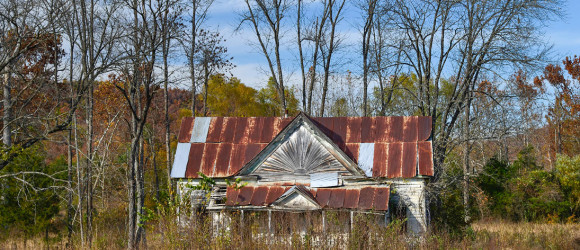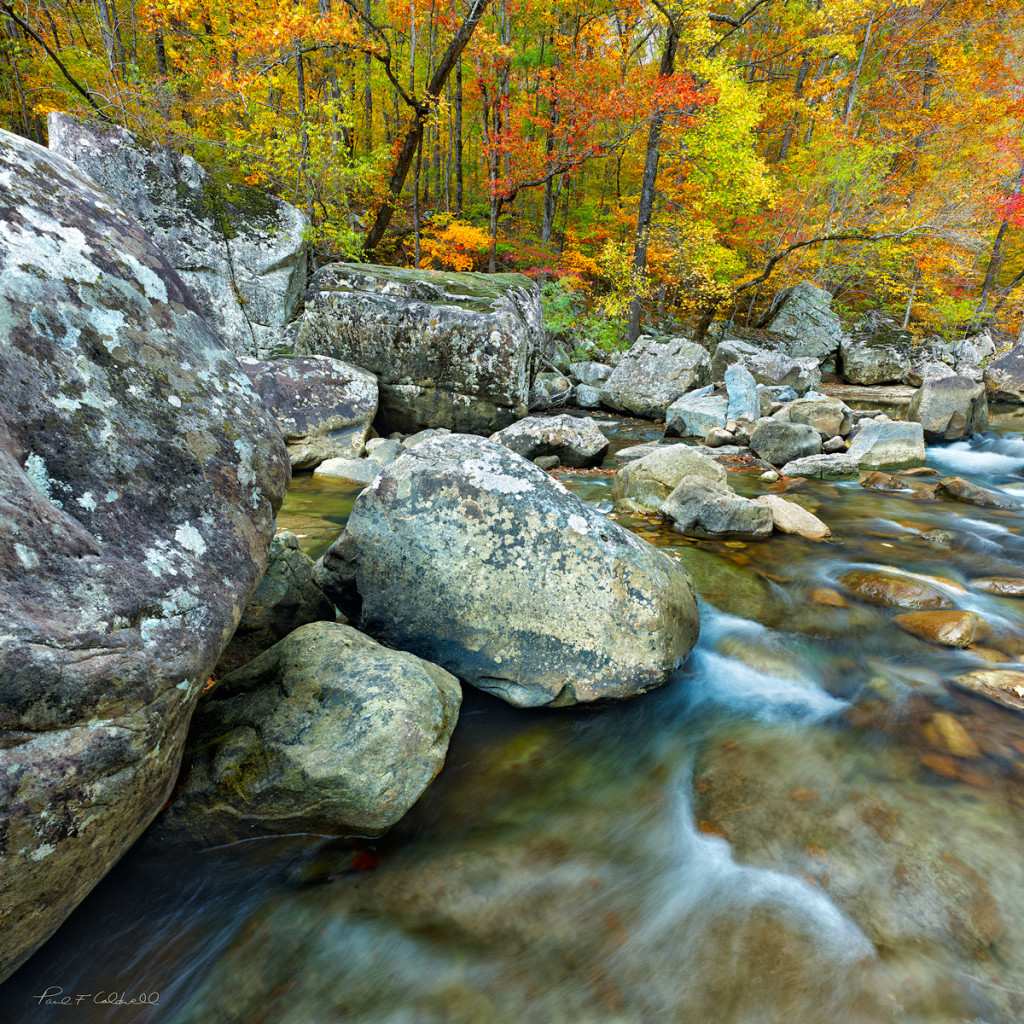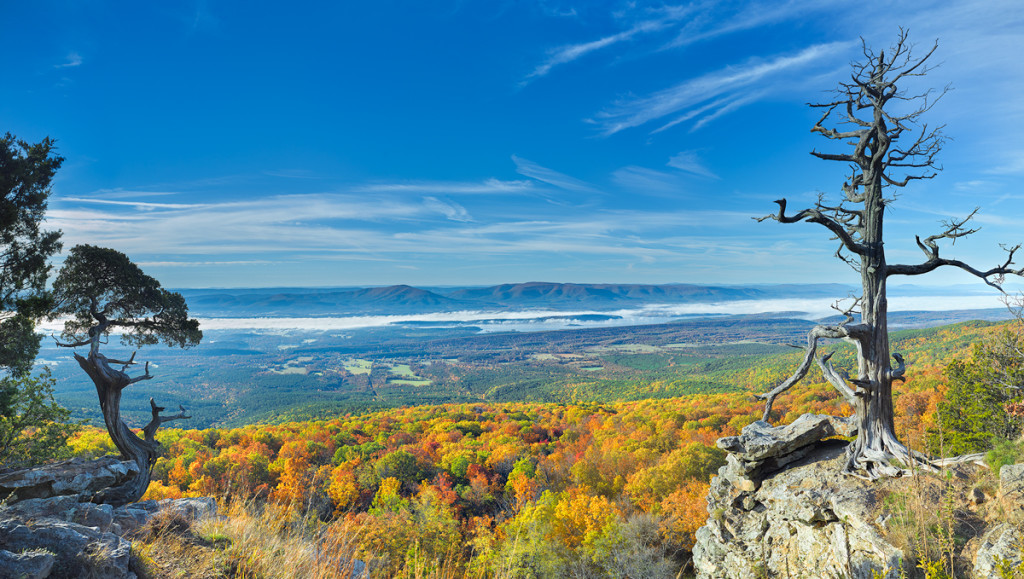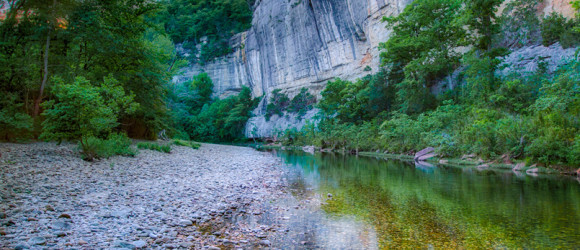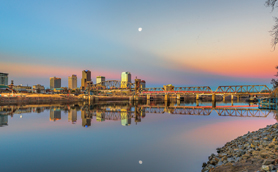Springtime sunset from Mt Magazine–03/23/15 Featured Arkansas Landscape Photography
- At March 23, 2015
- By paul
- In Featured Arkansas Photography
 0
0
Taken with a Nikon D800e, single exposure with 0.9 ND grad filter on a Nikon 14-24 lens, F7.1 for 1/6 of a sec @ iso 320. The views from Mt. Magazine are some of the best vistas in Arkansas. The valley to the south, which is featured here looks towards Blue Mountain and below it, Blue Mountain lake. It’s easy to see where the timber industry has harvested all the natural hardwoods, below the Mt. Magazine as the deciduous trees run down the mountain to the park boundary. Springtime is a special time in Arkansas, I like to call the power puff period as all the trees will have different shades of green for about 2 weeks. After that, all the leaves will take on a similar dark green hue until fall.
This shot features the most famous tree on Mt Magazine, the bonsai shaped juniper. I would have loved to make it up to this spot when the huge dead cedar was still alive as it is a huge tree. It’s interesting still standing there and when you look at the roots, you have to wonder how it managed to live as long as it did as the vast majority of them are above the ground on the rock. Mt Magazine is the tallest spot in Arkansas at around 2,700 feet high.
October Sunset on the Buffalo River at Roark Bluff–02/24/15 Featured Arkansas Photography
Taken with an Nikon D810, Nikon 14-24 lens @ 14mm F8, iso 64, 1/3 of a second in a single exposure.
This is one of those images that you have to work on a while, then come back to and work it some more and then again and again. I took this shot while on a sunset/night shoot with Chris Kennedy from Russellville. We were just setting up for the night, on 10/04/14, knowing that we were way to early for the maximum fall color display, however I wanted to work with the best moonlight for later on that evening. You can barely see some pretty strong color up on top of the bluff, and the trees on the right bank were showing a bit of yellow. I have been to this spot hundreds of times and sunsets here are hit and miss. I have one other shot that is similar taken over 2 years ago, where it was also dead calm and the clouds started to get illuminated by the sun.
On this evening it started out with nothing, then as the sun crept down the left side of the frame, a bunch of high clouds rolled in. I started immediately for a spot further down the river, where I know one of the best reflections can be taken from. You have to watch this spot when certain photographers are “teaching” as they will all line up here and block the river. However it was still a bit early for this particular photographer and his minions to flock down the river. Chris decided to stay up higher and go for a different shot, but I wanted the full bluff reflection. If there is no wind on the river the reflection here will be as sharp as looking in a mirror, which on this evening it was.
As the sun set, the light on the bluff and clouds just got better. The sun hit the far right side of the bluff and turned it yellow and the afterglow on the middle of the bluff took on a wonderful rose color. The fact that there was no wind offered one great reflection of both the bluff and the clouds. I started to shoot this series with the Nikon D810, and really was not paying much attention to my histogram. I was a bit more concerned about the trees and such in the foreground and forgot to look to see if I was blowing out the sky. I was right on the line of 255:255:255: as it turned out, but somehow manged to get 5 or 6 frames that were no blown. I really attribute this to the Nikon D810’s amazing range of dynamic range at the base iso of 64. Normally I would have setup a bracketed series of exposures, but the light was changing so fast, I just shot as fast as I could and manually tried to change the bracketing but I did not really change the exposure enough to really protect the sky. The D810 is bit more tricky on highlight recovery than the D800 was and I was still shooting with the D800 mindset.
I knew from memory just how dramatic the light was that evening, so I worked this image up about 3 different times and attached different aspects of it each time. One time the sky, then the bluff, then the shadows on both banks. My main goal was to capture the amazing play of light on the bluff, from the rose color to the bright golden color on the far right. I then had to work up the reflections and make sure that the colors matched.
This shot was totally worked up in Lightroom and Photoshop. I ended up going back and forth several times before I got the image the way I wanted it. I then tweaked the colors with Topaz Clarity, which is final step I use now on pretty much all my shots.
Overall, the end result is shown here and once again it shows just how beautiful the Buffalo River and it’s bluffs can be.
Moonset in Boxley Valley on the Buffalo National River–02/18/15 Featured Arkansas Photography
Taken with a Canon 5D MK2, Canon 24-70 lens at F5.6, iso 400 for 40 seconds.
This photograph was taken in early January 2009, back in the good old days for me at least, (if you know me well, you know what happened in February of 2009). I was on a trip to photograph Elk in the Boxley Valley and this was my first field use of my new Canon 5D MK2. Before I purchased the Canon 5D MK2, I had been using my older Canon 1ds MKII, which just did not have a very good higher iso range. On this morning, I came around the last bend of Hwy 21 as it drops down into the western end of the Boxley Valley and saw this view of the moon setting over one of the larger mountains that surround the valley. What caught my eye was how the shadows played with the fence row in the foreground. The old oak tree provided a nice touch also as I framed the shot between the branches. You can see just a very light layer of clouds or fog that was starting to rise up over the mountain in the background.
When you view this photograph up close, you can also see all the frozen dew drops on the grasses and fence posts. If you have never taken a trip to the Boxley Valley, which is on the western headwaters end of the Buffalo National River, it’s well worth the time.
Nighttime skies over Havana Arkansas revisited–02-09-15 Featured Arkansas Photography
Taken with a Nikon D800e, 14-24 Lens @ 15mm and F 3.5 in a series of stacked exposures. This shot was taken in February of 2013 on a very clear night from the summit of Mt. Magazine. The view is directly to the south looking over Havana Arkansas. In the distance you can see Blue Mt. Lake and Blue Mountain itself. I believe that Blue Mt. is the on the left. It would be a tall mountain if not for Mt. Magazine as Magazine dwarfs Blue Mountain.
This is one shot but it was composed by taking around 30 or so stacked exposures of 45 seconds. I had a 3/4 moon that night so the illumination down into the valley is all from the moon. I did some light painting on the tree on the left as the moon light was not going to get there until much later. I did not want to wait that long as by the time the moon would provide that illumination it would also be causing both flare and over exposure issues. This night there was quite a bit of traffic down in the valley along Hwy 10, but it just adds to the overall effect to me. I am always amazed when I look down into this valley during the day it’s hard to see any building of significant size, but at night even the smallest light will show up.
I first worked this shot up back in 2013 and thought I had a good version. Recently when viewing that shot, I realized that I had not been very accurate with the star trail work, and in fact I had a dip. This happens when you just slightly move the camera. It doesn’t take much to offset the trails. The best bet is just don’t touch anything until you are done. I say that, but I usually have to stop the series somewhere in the middle to see if I am getting some damaging flare. The Nikon 14-24 will flare with any amount of light that hits the outer element from the side and the flare can be very destructive and next to impossible to correct in post processing work. Flare tends to totally shift the blue of the sky to a red or yellow hue and tend to have a very hard demarcation which makes removal quite difficult.
Here is my first version of this work, and I greatly prefer the new one. I was able to pull out a lot more of the details in the valley. I also re-worked each of the images to try and pull out more of the trails on the left side. In this location the moon will pass from the left side to right and thus makes an even exposure pretty hard to obtain. However working in Lightroom and with some filters I have I pulled out more definition from the faint trails on the left side.
Old Home near St. Joe Arkansas–01/31/15 Featured Arkansas Photography
Taken with a Nikon D800e, Nikon 24-120mm lens, at around 35mm F5.6 iso 100 single exposure. This is one of the places I have driven by many times on the way to Woolum Ford on the Buffalo River. The home itself is in a total state of disrepair, but if you look closely at the front the woodwork there is most impressive. I would love to go up closer, but this is on private land. The weeds that have grown up around the front bothered me at first, but then after looking at the shot, I felt that they just added in. I love that fact that there are no power lines running to the building as they can be a pain to work with in post production. Someone spent a great deal of time on the decorative wood work on the front and most of it is still in place. One of the many old wonders in Arkansas.
Richland Creek in Autumn–12/18/14 Featured Arkansas Landscape Photography
Taken with a Phase One IQ160, Rodenstock 28mm HR lens, F11 for approximately 1 second, iso 50. Richland Creek, which runs from Newton County to the Buffalo River near Woolum Ford, has some of the most beautiful photographic subject matter in Arkansas, if you love creeks. Here you can find huge rocks that have ended up in the creek that had to have originated up much higher on the bluffs. Some of these rocks are the size of a small house and most are the size of a car. Richland creek has several sections that run over flat bedrock and this spot is one of them. This spot is about 100 yards long and starts out directly below Shaw’s Folly Rapid. The foliage on the left back, which is featured in this shot, is full of oaks, maples and hickory trees which on this day were all in full color. There was just enough water in the creek to allow for a movement shot. Normally, I like to have bright sunny days to work Richland, but on this day which was overcast I was able to get one of my best shots of the creek. Using tilt, I have gained quite a bit in overall depth of field so I was able to keep the details of the large rock on the left foreground in focus along with the trees in the background. This was a magic day for sure.
Mt. Magazine morning Vista–12/14/14 Featured Arkansas Photography
Taken with a Phase One IQ260 & Rodenstock 28mm HR lens, with an Arca rm3di, image created by combining 2 nodal pans. Mt. Magazine, which is the highest spot in Arkansas at around 2700 feet, has some wonderful views. One of the best is from from rock ledge below the Lodge where you have a wonderful view of the Blue Mountain, and Blue Mountain Lake off in the distance. This view is looking southwest, and shows the fall colors at peak or near peak. The deciduous trees in the area include, Maples, Hickory and various Oaks. You can also see the effect of the massive amount of forestry cutting in the lower valley which is beyond the boundary of the State Park where all the trees are now pines. These are not the natural pine to Arkansas, the short leaf, but instead Loblolly and or Slash pines, both of which were planted after the clear cuts were made. All of the lower foothills of Mt. Magazine are covered in this type of tree.
This is a hard shot to get in one frame with a 4:3 ratio camera like the IQ260 Medium Format back, so I worked in a series of pans, where I set the 28mm Rodenstock at a spot on my tripod that was close to the nodal point for the lens. This allowed me to pan across the scene and then combine the images into one larger frame later on. On this day, the sky was a radiant blue with some very high cirrus clouds that were rolling in from the west. With a tech camera like the Arca rm3di, and the Rodenstock 28mm lens, this type of shot is a bit more difficult since you have to correct for the color cast the lens creates. I used the Rodenstock Center filter on the lens and a linear polarizer to enhance both the blue in the sky and fall colors, as the sun was over my left shoulder and provided perfect conditions for polarization.
This is popular spot on the weekends, but during the week, most times you will not find anyone around so plan your trips accordingly. Make sure you take enough time to drive around the entire summit of Mt. Magazine as there are many great vantage points for photography.
10/14/14 Featured Arkansas Landscape Photography–Sunset at Roark Bluff on the Buffalo River
Taken with a Canon 5D MKII, Canon 14mm F 2.8 lens, in a bracketed series of exposures @ iso 200 This one is a special shot as it was one of those photographs that was just pure luck. I was up on the Buffalo River with Bob Shull, mainly to work the night skies, and we were just up on the river setting up our cameras. I had been looking downstream as the moon was starting to rise and it was in a very nice position. I had left my Canon 5D MKII setup for a upstream shot of Roark bluff for later that night. The evening skies had been cloudless, so I was not very interested in a sunset. I remember for some reason I looked around, probably due to a noise on the river, and wow, all of a sudden a bank of clouds had rolled at just the right time and they were on fire! I had to shoot the 5D MKII in a series of bracketed exposures as I knew that I would not be able to pull in the entire exposure with just one frame. This scene only lasted about 6 minutes and then the sun dropped below the bluff. My first series, missed the reflections of the sunset on the water at my feet. The river was not dead calm, but I still was able to pull in the reflection of the sunset on the water and the river rocks.
This was one of those once in a life time lucky lighting shots, that unless you happen to live on the river and can be out there everyday, just doesn’t happen very often. This was one of the last major photographs I took with the Canon, as I was in the process of transitioning to my Nikon D800, however I was much more familiar with the Canon at the time, so I shot with it.
09/28/14 Featured Arkansas Landscape Photography–Midnight at Haw Creek Falls
Taken with a Canon 6D, Canon 16-35 lens, at F4, iso 400, 2 hour time lapse photograph. This photograph was obtained by taking a series of 2 minute exposures from 10:00 pm to 12:15 am at Haw Creek Falls in the Arkansas Ozarks. I used a Canon 6D and a focal length of 18mm to take a series of 2 1/2 minute exposures. Each exposure was taken as raw file and developed in Lightroom, then I stacked them in Adobe Photoshop to capture only the motion of the earth over 2 hours which created the “trails. The blue color to the sky is from the moon, which was just a bit past 1/2 waxing. The moon adds both excellent ambient illumination to the night sky, giving it a blue hue, and also greatly adds to the landscape portion of the photograph. There was no light painting used on this photography, it’s all the light from the moon. I prefer this greatly over using artificial lighting, by painting as the moon just works better. You can read more about this technique in an article I wrote: Stacking for better nighttime photography. This photograph was taken in April of 2014, and spring was very late this year as can be seen in the trees on both banks of the creek.
I been working for a shot like this from Haw Creek for over 3 years. Catching the conditions all together can be harder than you think. You need a good flow of water, but not too much, as was present in March. The moon needs to be waxing for this shot, not waning or you will be up way to late waiting on the moon to appear. A clear sky is needed, with no clouds if possible and this does not always work out, as over 2 hours it’s quite common to see a front blow in. Also it work best if there is little to no wind. But since I am stacking I usually can find one of the stacks that has less wind noise than the rest.
This shot has it all, as you have great water, running over most of the ledge, and excellent play of shadows on the foreground. I am looking to the northwest, you can barely see where the north star is up in the upper right corner of the shot. It’s not very easy to get a good shot of the falls and the north star from below the drop, but the wide angle lens I was using did grab a nice portion of the sky. Of all the photograph I work with, nighttime stacking takes by far the greatest amount of time, both in the capture of the images and post processing, however I love the look of what I can create.
08/20/14 Featured Arkansas Photography–Bliss
Taken with a Fuji X-T1, 14mm lens @ F4, iso 400. Not too much to say on this one, I wanted to test out the new 14mm lens I had picked up for my Fuji X-T1 and my dog scout was totally engrossed in the testing as you can tell. Dogs can make life seem waay too complicated.










